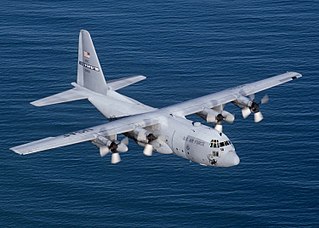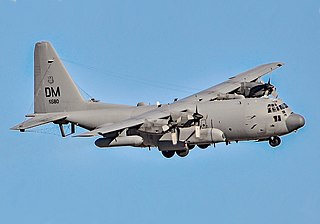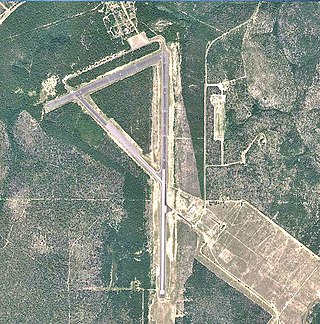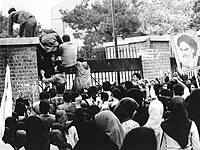
The Lockheed AC-130 gunship is a heavily armed, long-endurance, ground-attack variant of the C-130 Hercules transport, fixed-wing aircraft. It carries a wide array of ground-attack weapons that are integrated with sensors, navigation, and fire-control systems. Unlike other modern military fixed-wing aircraft, the AC-130 relies on visual targeting. Since its large profile and low operating altitudes around 7,000 feet make it an easy target, its close air support missions are usually flown at night.

The Lockheed C-130 Hercules is an American four-engine turboprop military transport aircraft designed and built by Lockheed. Capable of using unprepared runways for takeoffs and landings, the C-130 was originally designed as a troop, medevac, and cargo transport aircraft. The versatile airframe has found uses in other roles, including as a gunship (AC-130), for airborne assault, search and rescue, scientific research support, weather reconnaissance, aerial refueling, maritime patrol, and aerial firefighting. It is now the main tactical airlifter for many military forces worldwide. More than 40 variants of the Hercules, including civilian versions marketed as the Lockheed L-100, operate in more than 60 nations.

JATO is a type of assisted take-off for helping overloaded aircraft into the air by providing additional thrust in the form of small rockets. The term JATO is used interchangeably with the term RATO, for rocket-assisted take-off.

The EC-130H Compass Call is an electronic attack aircraft flown by the United States Air Force. Based on the Lockheed C-130 Hercules, the aircraft is heavily modified to disrupt enemy command and control communications, perform offensive counterinformation operations, and carry out other kinds of electronic attacks. Planned upgrades will add the ability to attack early warning and acquisition radars. Based at Davis-Monthan AFB in Arizona, EC-130Hs can be deployed worldwide at short notice to support U.S. and allied strategic and tactical air, surface, and special operations forces.

The Lockheed HC-130 is an extended-range, search and rescue (SAR)/combat search and rescue (CSAR) version of the C-130 Hercules military transport aircraft, with two different versions operated by two separate services in the U.S. armed forces.

The Lockheed MC-130 is the basic designation for a family of special mission aircraft operated by the United States Air Force Special Operations Command (AFSOC), a wing of the Air Education and Training Command, and an AFSOC-gained wing of the Air Force Reserve Command. Based on the Lockheed C-130 Hercules transport, the MC-130s' missions are the infiltration, exfiltration, and resupply of special operations forces, and the air refueling of (primarily) special operations helicopter and tilt-rotor aircraft.

The Lockheed LC-130 is a ski-equipped United States Air Force variant of the C-130 Hercules used in the Arctic and Antarctic. Ten are currently in service with the 109th Airlift Wing of the New York Air National Guard.

A retrorocket is a rocket engine providing thrust opposing the motion of a vehicle, thereby causing it to decelerate. They have mostly been used in spacecraft, with more limited use in short-runway aircraft landing. New uses are emerging since 2010 for retro-thrust rockets in reusable launch systems.

The Kawasaki C-1 is a twin-engined short-range military transport aircraft developed and manufactured by the Japanese conglomerate Kawasaki Heavy Industries. It is solely used by the Japan Air Self-Defense Force (JASDF).

Duke Field, also known as Eglin AFB Auxiliary Field #3, is a military airport located three miles (5 km) south of the central business district of Crestview, in Okaloosa County, Florida, United States.

The 7th Special Operations Squadron is an active flying unit of the United States Air Force. It is a component of the 752d Special Operations Group, United States Special Operations Command, and is currently based at Royal Air Force Station Mildenhall in Suffolk, UK. From their base at RAF Mildenhall, the 7th Special Operations Squadron is able to deploy or extract troops from hostile, sensitive, or otherwise undesirable locations.

The 919th Special Operations Wing is an Air Reserve Component (ARC) unit of the United States Air Force. The 919 SOW is assigned to the Tenth Air Force of the Air Force Reserve Command (AFRC) and is stationed at Duke Field, Florida.

The 156th Wing is a unit of the Puerto Rico Air National Guard, stationed at Muñiz Air National Guard Base, in Carolina, Puerto Rico. If activated to federal service with the United States Air Force, the wing is operationally gained by the Air Mobility Command (AMC). It traces its history to the creation of the 156th Tactical Fighter Group in 1962.

The 550th Special Operations Squadron was a special operations flying training squadron of the United States Air Force.

The Fairchild AU-23 Peacemaker is an American armed gunship, counter-insurgency, utility transport aircraft developed from the Pilatus PC-6 Porter for the United States Air Force. A total of 35 were built under license in the United States by Fairchild Industries, for use during the Vietnam War in the early 1970s. All aircraft were later sold to the Royal Thai Air Force.

Wagner Field,, is a component of Eglin Air Force Base, Florida. It is located northeast of the main base, 13.9 miles northeast of Valparaiso, Florida.

The Lockheed MartinKC-130 is a family of the extended-range tanker version of the C-130 Hercules transport aircraft. The KC-130J is the latest variant operated by the United States Marine Corps (USMC), with 48 delivered out of 79 ordered. It replaced older KC-130F, KC-130R, and KC-130T variants for aerial refueling. USMC reserve unit, VMGR-452 operated 12 KC-130T aircraft until May 2021; this was the last USMC reserve unit that operated the legacy KC-130s, completing the Corps' transition to the more advanced Super Hercules.
The 1198th Operational Evaluation and Training Squadron was a unit at Norton Air Force Base, San Bernardino, California from 1965 to 1972 which conducted the initial testing of Lockheed C-130 Hercules transports modified for special operations. This went on under the project names of Thin Slice and Heavy Chain which led to the MC-130 Combat Talons, still a key component of Air Force Special Operations Command. Its initial commander was Lt. Col. Robert Marks.

On May 2, 2018, a Lockheed WC-130H transport aircraft of the Puerto Rico Air National Guard crashed in the US state of Georgia, shortly after departing from Savannah Air National Guard Base. The aircraft crashed on Georgia State Route 21 at 11:26 local time. All nine airmen were killed in the accident. All nine were members of the Puerto Rico Air National Guard.



















